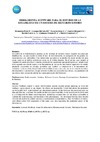Please use this identifier to cite or link to this item:
https://accedacris.ulpgc.es/jspui/handle/10553/55530
| Title: | Herramienta software para el estudio de la estabilidad de un sistema de refuerzo sonoro | Authors: | Hernández-Pérez, Eduardo Campos Herrera, D. I. Navarro Mesa, J. L. Guerra-Moreno, Iván Ravelo-García, A. G. Quintana-Morales, P. J. Martín-González, S.I. |
UNESCO Clasification: | 330702 Electroacústica | Keywords: | Realimentación acústica Refuerzo sonoro Sistemas electroacústicos Simulación de sistemas Acoustic Feedback |
Issue Date: | 2016 | Abstract: | El control de la realimentación acústica en los sistemas de refuerzo sonoro requiere una adecuada planificación, ya que cuando se cierra el lazo de realimentación, en cualquiera de sus grados, las consecuencias son indeseables. Una herramienta que permita su predicción puede resultar de gran ayuda, tanto en el ámbito profesional como en el ámbito docente. En el primer caso permite al ingeniero de sonido planificar y simular, previendo las condiciones que pueden provocar inestabilidad, en el segundo caso puede usarse como herramienta de formación para futuros ingenieros de sonido, simulando situaciones no siempre accesibles que faciliten la comprensión y el tratamiento del fenómeno. La herramienta desarrollada se ha dividido en secciones cada una en su contexto (acústico, electroacústico y geométrico), lo que creemos facilita una actuación más directa con parámetros de una misma clase, separando además las causas particulares del fenómeno. Acoustic feedback control in sound reinforcement systems requires proper planning, as when the feedback loop is closed, in any degree, the effects are undesirable. A tool that allows the prediction can be helpful, both in professional and educational contexts. In the first case the sound engineer can plan and simulate in advance the conditions that can cause instability, in the second case it can be used as a training tool for future sound engineers, simulating situations that are not always accessible to facilitate the understanding and treatment of the phenomenon. The developed tool has been divided into sections each in its context (acoustic, electroacoustic and geometric), what we believe provides a more direct action with parameters of the same class, also separating the particular causes of the phenomenon. |
URI: | https://accedacris.ulpgc.es/handle/10553/55530 | ISBN: | 978-84-87985-27-0 | Source: | 9th Iberian Acoustics Congress. 47º Congreso Español de Acústica. TECNIACUSTICA® 2016. EuroRegio2016, june 13-15, 2016, Porto, Portugal |
| Appears in Collections: | Actas de congresos |
Page view(s)
209
checked on Mar 1, 2025
Download(s)
179
checked on Mar 1, 2025
Google ScholarTM
Check
Altmetric
Share
Export metadata
Items in accedaCRIS are protected by copyright, with all rights reserved, unless otherwise indicated.
